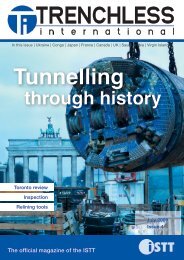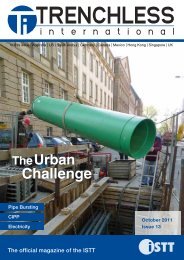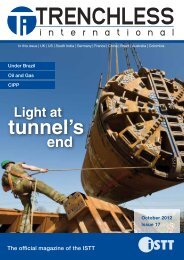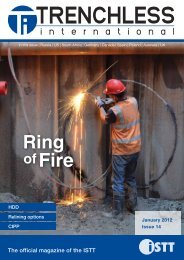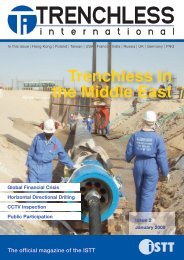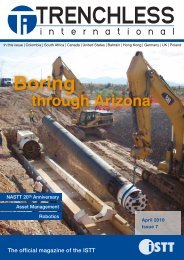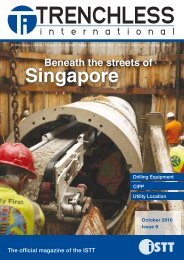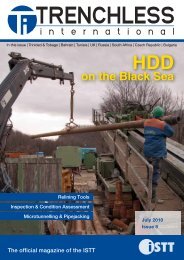North American Special - Trenchless International
North American Special - Trenchless International
North American Special - Trenchless International
You also want an ePaper? Increase the reach of your titles
YUMPU automatically turns print PDFs into web optimized ePapers that Google loves.
north america<br />
April 2009 - <strong>Trenchless</strong> <strong>International</strong><br />
• Geophysical surveys of 29 km of tunnel<br />
• Probe and core drilling<br />
• Fibre optic scope inspection<br />
• Test grouting program<br />
• Epoxy mortar lining – test section<br />
• High quality video recording<br />
• Walk-through inspections in 5.3 km<br />
length of pressurised section of NCA.<br />
In general the design phase focused on<br />
restoration of the brick lining rather than<br />
its replacement with concrete or shotcrete.<br />
Where significant defects had been<br />
observed in previous inspections and were<br />
determined to require larger-scale repairs,<br />
in situ concrete was used. (Figure 2). The<br />
design phase also considered temporary<br />
structures, such as the design of standby<br />
bulkheads to fit inside the shafts in the<br />
pressurised section of the NCA. These<br />
temporary bulkheads would serve as a<br />
means of restoring the service of the NCA<br />
should it be required to provide water<br />
to the city in the event of an emergency<br />
situation elsewhere in the water supply<br />
system. In addition, the design phase<br />
included mechanical engineering for the<br />
inspection and replacement of ageing<br />
infrastructure such as pipes, gates and<br />
valves.<br />
Diagram showing the horseshoe-shaped<br />
brick liner of the New Croton Aqueduct in<br />
the gravity flow portions of the alignment.<br />
The profile on the left shows a typical cutand-cover<br />
section: the profile on the right is<br />
typical of the mined sections. Source: The<br />
City of New York Aqueduct Commission,<br />
1895.<br />
Part 2: inspection<br />
Objective<br />
The objective of the shaft and tunnel<br />
inspections was to locate and document<br />
defects. Information gathered during the<br />
visual inspection was used to establish<br />
focal areas for both future repair contracts<br />
and further field investigation, which<br />
included coring, probe drilling, fibre optic<br />
scope inspection and test grouting.<br />
Inspection of the tunnel and shafts<br />
The scope of the inspection work<br />
under the construction contract included<br />
assessing the condition of the 9.6 km long<br />
pressurised section of NCA and inspection<br />
of shafts, headhouses and blow-off structures<br />
in both the pressurised and gravity<br />
sections.<br />
Tunnel inspection was performed<br />
between stations. Brick-lined portions of<br />
the tunnel and shafts were sounded, and<br />
the entire tunnel alignment was visually<br />
inspected. Potential voided areas were<br />
recorded in the field log and marked on the<br />
wall for possible future probe hole drilling.<br />
The lowest part of the invert was typically<br />
covered with water 100 to 200 mm deep,<br />
preventing inspection; but defects were<br />
noted when observed.<br />
The siphon under the Harlem River<br />
extends to a depth of 122 m. The purpose<br />
of performing an ROV inspection instead<br />
of dewatering the siphon and performing<br />
a walk-through inspection, was to minimise<br />
the risk of the lining buckling due<br />
to external water pressure acting on an<br />
empty lining. The siphon has never needed<br />
dewatering since it was brought into operation<br />
in 1891. The ROV was equipped with<br />
high resolution video and dual imaging<br />
sonar instruments. The objective was to<br />
verify shaft and siphon lining materials and<br />
construction features, to assess sediment<br />
levels and debris accumulations, to locate<br />
defects and to obtain video and sonic<br />
records of the structures.<br />
Testing<br />
the ground<br />
Non-destructive geophysical testing was<br />
performed within Gould’s Swamp and a<br />
fibre optic testing program was conducted<br />
at locations that appeared from the visual<br />
and geophysical investigations to merit<br />
Test grouting operations in the Bronx pressurised<br />
aqueduct.<br />
further investigation.<br />
Continuous diamond core drilling was<br />
performed on selected areas of the aqueduct<br />
to obtain samples of the tunnel lining,<br />
mortared and grouted rubble, and foundation<br />
bedrock for material identification and<br />
laboratory testing to determine engineering<br />
properties. Test grouting was performed in<br />
both the Bronx and Manhattan pressurised<br />
tunnels and at two shaft locations.<br />
The comprehensive field investigation<br />
program was used to assess the current<br />
condition of the NCA and to design a<br />
rehabilitation program. Overall, the tunnel<br />
and shafts are in very good condition,<br />
with reparable leaks or defects at some<br />
locations. The visual inspection identified<br />
tunnel defects and the geophysical inspection<br />
determined the condition of the brick<br />
liner and the grouted and mortared rubble<br />
backing. Visual and geophysical inspection<br />
findings frequently complement the laboratory<br />
test results. The test grouting program<br />
successfully stopped or decreased<br />
inflows into the test areas. The locations<br />
of abandoned shafts were verified using<br />
geophysical methods. Investigations of the<br />
‘soft rock zone’ determined that the area is<br />
geologically stable.<br />
There are a total of 49 shafts along the<br />
aqueduct alignment, ranging from large<br />
chambers in cut-and-cover sections, to<br />
small diameter shafts up to 113 m deep.<br />
Seventeen of these shafts were filled at<br />
the end of construction and are difficult<br />
to detect from the ground surface or from<br />
within the tunnel. Eight shafts were lined<br />
with a combination of brick and Cast Iron.<br />
Most were rimmed with granite collars, typically<br />
350 mm thick, at the surface. Collars<br />
at the tunnel intersection are up to 600 mm<br />
thick. Most shafts had steel ladders from<br />
the ground surface to the tunnel crown<br />
which often exhibited oxidation, tuberculation<br />
and/or section loss. The shafts were in<br />
very good to excellent condition, overall.<br />
The Harlem River siphon and associated<br />
structures were successfully inspected by<br />
a ROV and found to be aligned according<br />
to historic drawings and without evidence<br />
of major displacement or defects.<br />
Heavy groundwater inflow encountered<br />
after drilling into a water-filled void. Inflow<br />
rates subsided over the following 48 hours<br />
and were significantly reduced after grouting.<br />
Part 3: rehabilitation<br />
The goal of the project was to restore<br />
the gravity flow section of the aqueduct<br />
to optimal operating condition, thus<br />
extending the lifespan of this significant<br />
water supply for the New York City<br />
metropolitan area. A large-scale contact<br />
grouting program was performed in the<br />
horseshoe-shaped gravity flow sections<br />
of the aqueduct, with the objective of<br />
filling identified voids behind the liner,<br />
filling fractures in broken mortared and<br />
grouted rubble and foundation bedrock<br />
materials, and reducing water infiltration<br />
into the tunnel.<br />
Cover depths of the aqueduct vary considerably,<br />
ranging from a few to hundreds<br />
of metres, typically consisting of hard<br />
rock. Primarily mined using conventional<br />
methods of the late 1800s, construction<br />
of the NCA also employed cut-and-cover<br />
methods in several low-lying sections of<br />
the alignment, totalling approximately 1.6<br />
km. The NCA passes through numerous<br />
lithologic changes, fault/shear zones and<br />
under several significant water bodies,<br />
including the Pocantico and Saw Mill<br />
Rivers and the Tarrytown Reservoir. It<br />
also passes under the Harlem River as a<br />
siphon at a depth of approximately 122<br />
metres below grade.<br />
Soon after construction, reports on the<br />
NCA from The Aqueduct Commission<br />
documented prominent defects in the tunnel,<br />
such as large voids behind the lining.<br />
More recently, large-scale inspections<br />
of the gravity flow section, performed<br />
during the 1990s, and a 2004 inspection<br />
of portions of the pressurised sections,<br />
have revealed additional defects, such<br />
as open and/or deteriorated masonry<br />
joints/cracks, leaks ranging from trickles<br />
to several gallons per minute into and out<br />
of the aqueduct, missing bricks, formed<br />
openings, and in one place, a rupture<br />
through the liner with discernible offset.<br />
Despite these defects, the generally<br />
good condition of the NCA is remarkable.<br />
It is not uncommon to traverse several<br />
miles through the aqueduct without noting<br />
any significant defects.<br />
Major liner repair<br />
Major liner repair work consisted of<br />
cast-in-place reinforced concrete for filling<br />
of existing formed openings located at<br />
or near the crown of the tunnel and areas<br />
of brick heave located within the tunnel<br />
invert. Areas requiring brick replacement<br />
were minimal, totalling only 14.8 square<br />
metres.<br />
The successful rehabilitation of the<br />
38 km long gravity flow section of the<br />
New Croton Aqueduct resulted from<br />
good management and positive working<br />
relationships among the owner,<br />
the engineering consultants and the<br />
contractor. The rehabilitation was completed<br />
on schedule within approximately<br />
17 months, with crews working a typical<br />
eight-hour work shift five days a week.<br />
This is an edited version of a paper by A. Noble,<br />
D. Roberts and A. Fareth. Please refer to the paper<br />
for more detailed information, acknowledgements<br />
and references.<br />
north america<br />
April 2009 - <strong>Trenchless</strong> <strong>International</strong><br />
58<br />
59




